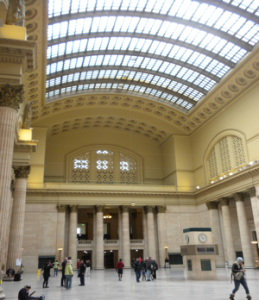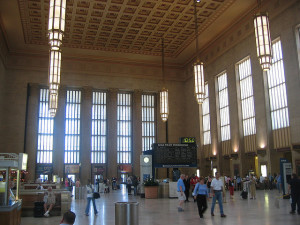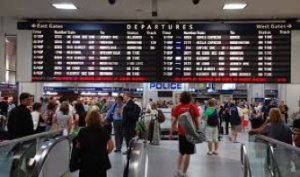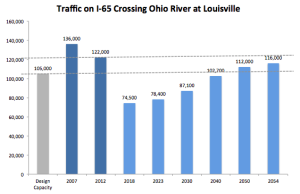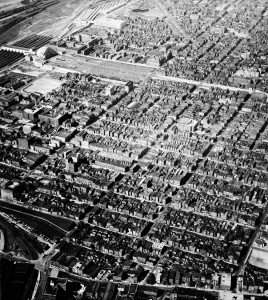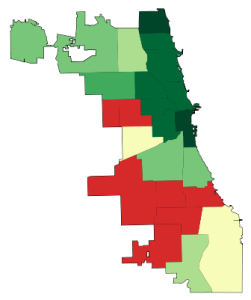This post is part of a series called North America’s Train Stations: What Makes Them Sustainable — or Not? See the series introduction for more. The photo above is how I used to think of Union Station: the architecturally famous Great Hall. But as the nation’s third largest station, I always wondered why so few people were in it. Before I share the answer, please allow this summary background. Score: 61 (see full scorecard) Category: Inexcusable This series’ previous post analyzed Philadelphia’s Center City stations as representing … [Read more...]
Philadelphia Center City Stations
Philadelphia Market East Station. Photo Credit: Flickr/acetonicThis post is part of a series called North America’s Train Stations: What Makes Them Sustainable — or Not? See the series introduction for more. In the series introduction, I divided America’s stations into four categories based on how they are evolving to sustainability. The first was “The Likely Sustainables.” While most cities have plans to reutilize their central station, these cities are doing it best. These stations serve compact cities and are using these economic … [Read more...]
North America’s Train Stations: What Makes Them Sustainable – or Not?
[ Today and Tuesday I'm kicking off a series by Robert Munson that reviews North America's train stations. Entries will be posted periodically as Robert writes them. Today is the set up followed by Philadelphia, and many more analyses that should surely get people arguing - Aaron.] Before cities waste more time and money fumbling, let’s first describe how train stations should serve the 21st Century. Which of these encourages you to travel by train? New York’s former Penn Station was cathedral-like, an elegant concourse and … [Read more...]
Louisville Bridges Project Proceeds From Tragedy to Farce
I've written a lot about the $2.6 billion boondoggle project to build two new bridges across the Ohio River in Louisville (see here, here, here, here, here, here, and here). A new East End river crossing is without a doubt necessary and adds regional value, but the rest of the project is basically bad news. But no matter how crazy this project is, it always manages to find ways to show that it's even more wacky than I thought. The latest installment comes from the so-called "investment grade toll study" that was conducted in order to set … [Read more...]
Boston: Whither Somerville?
[ Urbanophile reader Andrew Zimmermann sends us this tale of change in Somerville, a suburban town near Boston - Aaron. ] Urban planners have long cast the artist and gay/lesbian communities as urban pioneers and harbingers of gentrification. We’ve heard the stories of North Halsted in Chicago, the Pearl District in Portland, the South End in Boston and Soho/Chelsea in Manhattan. But, ever since hipsters became part of the sub-culture lexicon, urban experts have blamed gentrification on them. From Williamsburg, Brooklyn to the Mission in San … [Read more...]
The Promise and the Peril of Rust Belt Chic
What do you do when you're a post-industrial city fallen on hard times? There's a sort of default answer in the marketplace that I'll call for want of a better term the "Standard Model." The Standard Model more or less tells cities to try to be more like Portland. That is, focus on things like local food, bicycles, public transit, the arts, New Urbanist type real estate development, upscale shopping, microbreweries, coffee shops, etc., etc. The idea seems to be that the Rust Belt city model is a failure and should be chucked in favor of … [Read more...]
Making the Link Between Quality of Life and Economic Development
A rather prosaic economic development announcement in Indianapolis provides an opportunity to hammer home in a concrete way the connection between quality of life investments and economic development. This is something I've long argued we urbanists do a poor job of. We tend to adopt a "build it and they will come" marketing approach to quality of life initiatives where the connection between cause and effect is tenuous. Additionally, these tend to focus almost entirely on and tell stories about "the best and brightest" which in a country dying … [Read more...]
In Case You’ve Forgotten How Badly Freeways Damaged Our Cities, Cincinnati Edition
A couple weeks ago I posted a series of photos demonstrating the damage freeway construction did to Indianapolis. Since I've been covering Cincinnati this week, I thought I'd show the damage freeways did there too. Over the Rhine is one of America's most stunning historic districts. When I visited the city last year, one of the locals explained that there had been "miles" of neighborhoods just like it obliterated by freeway construction. I found this difficult to credit until I came across the photographic proof. Here's a picture of one … [Read more...]
Rezoning Midtown East by Micah Rodman
[ Many of you are probably aware by now that New York Mayor Michael Bloomberg is pushing to upzone the Midtown East area around Grand Central Terminal before he leaves office. Micah Rodman, a student at Yale, wrote an a paper on this I thought would be of interest as an example showing the way Bloomberg has been seeking to reshape New York - Aaron. ] Currently, the New York City Department of Urban Planning is in the public approval process of changing the zoning for East Midtown as a means of redeveloping the neighborhood. In this 73-block … [Read more...]
The Growing Public Safety Inequality Gap in Chicago
[ Daniel Hertz writes over at his City Notes blog. He was gracious enough to give me to permission to repost the results of his research into changes in crime patterns in Chicago over time - Aaron. ] Here are two maps: HOMICIDE RATE BY POLICE DISTRICT 1990-1993 2008-2011 Like the captions say, the one on the left shows homicide rates by police district in the early 90s, when crime was at its peak in Chicago, and the one on the right shows the same thing, but about two decades later.* The areas in dark green are the … [Read more...]
- « Previous Page
- 1
- …
- 17
- 18
- 19
- 20
- 21
- …
- 36
- Next Page »
